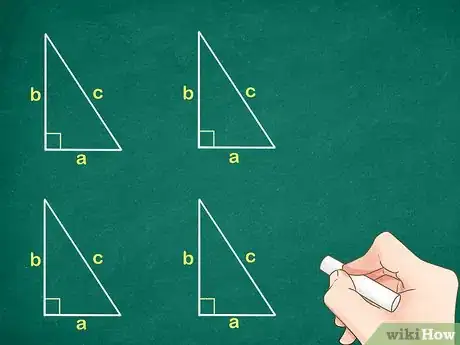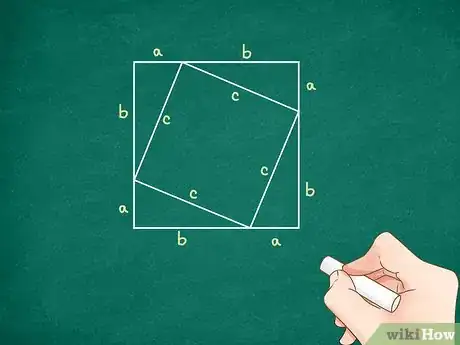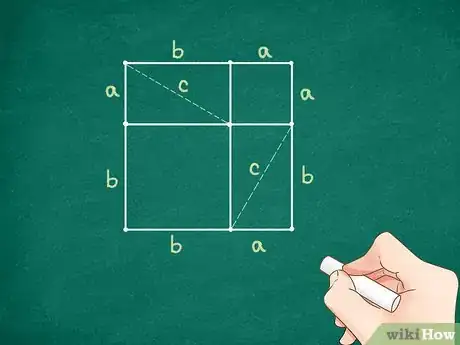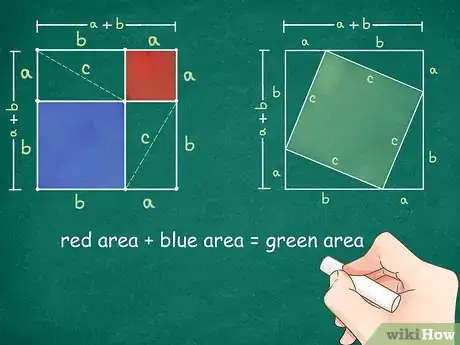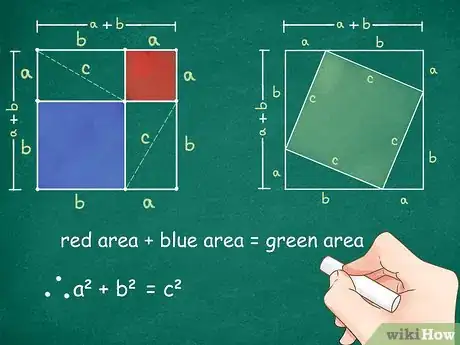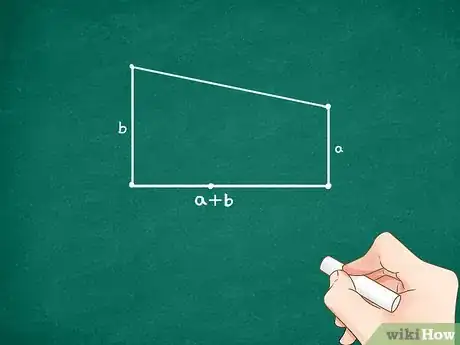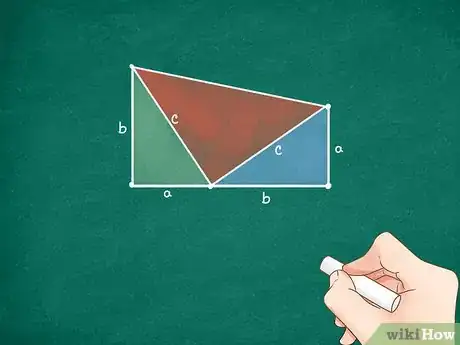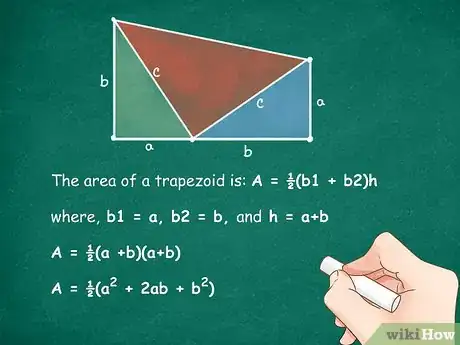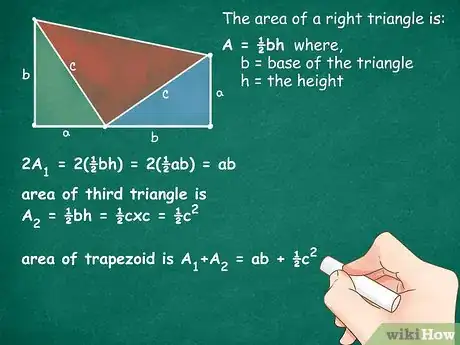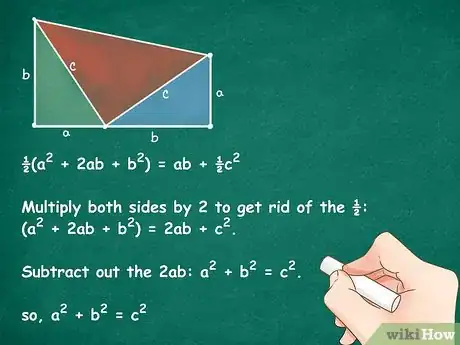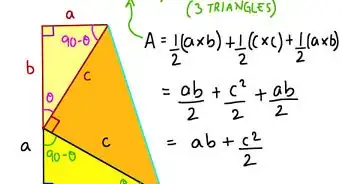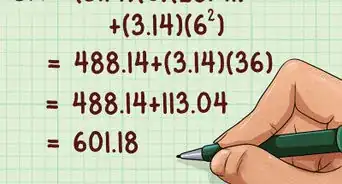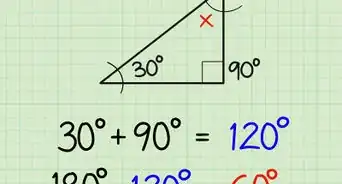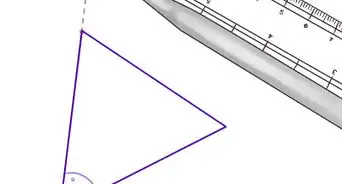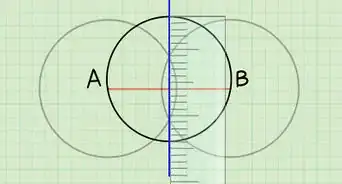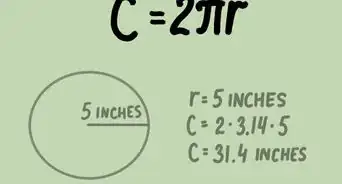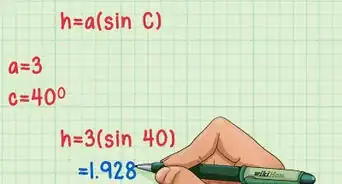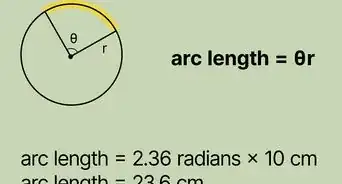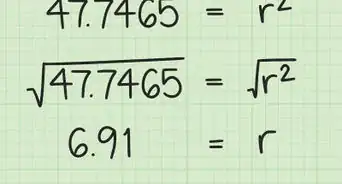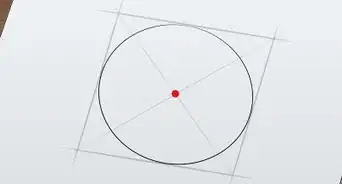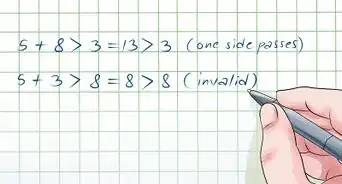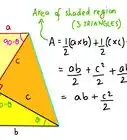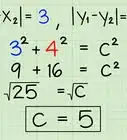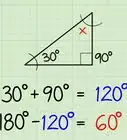This article was co-authored by wikiHow Staff. Our trained team of editors and researchers validate articles for accuracy and comprehensiveness. wikiHow's Content Management Team carefully monitors the work from our editorial staff to ensure that each article is backed by trusted research and meets our high quality standards.
There are 7 references cited in this article, which can be found at the bottom of the page.
This article has been viewed 150,670 times.
Learn more...
The Pythagorean Theorem allows you to work out the length of the third side of a right triangle when the other two are known. It is named after Pythagoras, a mathematician in ancient Greece.[1] The theorem states that the sum of the squares of the two sides of a right triangle equals the square of the hypotenuse: a2 + b2 = c2.[2] The theorem can be proved in many different ways involving the use of squares, triangles, and geometric concepts. Two common proofs are presented here.
Steps
Using Squares
-
1Draw four congruent right triangles. Congruent triangles are ones that have three identical sides. Designate the legs of length a and b and hypotenuse of length c. The Pythagorean Theorem states that the sum of squares of the two legs of a right triangle is equal to the square of the hypotenuse, so we need to prove a2 + b2 = c2.
- Remember, the Pythagorean Theorem only applies to right triangles.[3]
-
2Arrange the triangles so that they form a square with sides a+b. With the triangles placed in this way, they will form a smaller square (in green) inside the larger square with four equal sides of length c, the hypotenuse of each triangle.[4] The larger square has sides of length a+b.
- You can rotate (turn) the entire arrangement by 90 degrees and it will be exactly the same. You can repeat this as many times as you like. This is only possible because the four angles at the corners are equal.
Advertisement -
3Rearrange the same four triangles such that they form two equal rectangles inside a larger square. Again, the larger square will have sides of length a+b, but in this configuration there are two rectangles (in grey) of equal size and two smaller squares within the larger square. The larger of the smaller squares (in red) has sides of length a, while the smaller square (in blue) has sides of length b.[5]
- The hypotenuse of the original triangles is now the diagonal of the two rectangles formed by the triangles.
-
4Recognize that the area not formed by the triangles is equal in both arrangements. In both cases, you have a large square with sides of a+b. Given this, the areas of both of the large squares are equal. Looking at both arrangements, you can see that the total area of the green square must equal the areas of the red and blue squares added together in the second arrangement.
- In both arrangements we partially covered the surface with exactly the same amount, four grey triangles that didn't overlap. This means that also the area left out by the triangles must be equal in both arrangements.
- Therefore, the area of the blue and the red square taken together must be equal to the area of the green square.
-
5Set the areas of each arrangement equal to each other. The blue area is a2, the red area, b2 and the green area, c2. The red and blue squares must be added together to equal the area of the green square; therefore, blue area + red area = green area: a2 + b2 = c2.[6]
- This finishes the proof.
Using Trapezoids
-
1Draw a trapezoid with base a+b and sides a and b. Sketch a trapezoid with the following measurements: left side of height b, right side of height a, and base of length a+b. Simply connect the tops of the left and right sides to complete the trapezoid.
-
2Divide the trapezoid into three right triangles, two of which are congruent. Divide the base of the triangle into lengths a and b so that two right triangles of lengths a, b, and c is formed. The third triangle will have two sides of length c and a hypotenuse of length d.[7]
- The two smaller triangles are congruent (identical).
-
3Calculate the area of the trapezoid using the area formula. The area of a trapezoid is: A = ½(b1 + b2)h where b1 is one straight side of the trapezoid, b2 is the other straight side of the trapezoid, and h is the height of the trapezoid.[8] For this trapezoid: b1 is a, b2 is b, and h is a+b.
- The area of this trapezoid is A = ½(a +b)(a+b) .
- Expanding the binomial yields: A = ½(a2 + 2ab + b2).
-
4Find the area by summing the areas of the three triangles. The area of a right triangle is: A = ½bh where b is the base of the triangle and h is the height. This trapezoid has been broken into three different triangles; therefore, the areas need to be added together. First, find the area of each one and then add all three together.
- Because two of the triangles are identical, you can simply multiply the area of the first triangle by two: 2A1 = 2(½bh) = 2(½ab) = ab.
- The area of the third triangle is A2 = ½bh = ½c*c = ½c2.
- The total area of the trapezoid is A1 + A2 = ab + ½c2.
-
5Set the different area calculations equal to each other. Because both of these calculations are equal to the total area of the trapezoid, you can set them equal to each other. Once they’re set equal to each other, you can reduce the equation to its simplest form.[9]
- ½(a2 + 2ab + b2) = ab + ½c2.
- Multiply both sides by 2 to get rid of the ½: (a2 + 2ab + b2) = 2ab + c2.
- Subtract out the 2ab: a2 + b2 = c2.
- You’re left with the proof: a2 + b2 = c2.
Community Q&A
-
QuestionIn the example images, how did the red area and blue area equal the green area?
 Community AnswerThat's the trick. It's hard to tell directly that red + blue = green. If you could, the Pythagorean Theorem would be obvious. The areas of both big squares are equal to (a+b)^2. If you take away 2ab in the form of two a by b rectangles, you are left with the red and blue squares shown in the left diagram. If you take away 2ab in the form of four a by b right triangles, you are left with the green square in the diagram on the right. If you start with equal areas, and subtract equal areas, what you are left with must have equal areas.
Community AnswerThat's the trick. It's hard to tell directly that red + blue = green. If you could, the Pythagorean Theorem would be obvious. The areas of both big squares are equal to (a+b)^2. If you take away 2ab in the form of two a by b rectangles, you are left with the red and blue squares shown in the left diagram. If you take away 2ab in the form of four a by b right triangles, you are left with the green square in the diagram on the right. If you start with equal areas, and subtract equal areas, what you are left with must have equal areas. -
QuestionHow do I cite this page?
 DonaganTop AnswererCite it as the article "How to Prove the Pythagorean Theorem" at wikiHow.com.
DonaganTop AnswererCite it as the article "How to Prove the Pythagorean Theorem" at wikiHow.com. -
QuestionIs there any other method, preferably involving more of algebra and less of geometry, to prove the Pythagorean Theorem?
 Community AnswerThe Pythagorean Theorem is a generalization of the Cosine Law, which states that in any triangle: c² = a² + b² - 2(a)(b)(cos(C)), where C is the angle opposite side c. In a right triangle, where a and b are the legs, and c is the hypotenuse, we have (because the right angle is opposite the hypotenuse): c² = a² + b² - 2(a)(b)(cos(90)). Because cos(90) = 0, the whole equation simplifies to c² = a² + b², which is the Pythagorean Theorem.
Community AnswerThe Pythagorean Theorem is a generalization of the Cosine Law, which states that in any triangle: c² = a² + b² - 2(a)(b)(cos(C)), where C is the angle opposite side c. In a right triangle, where a and b are the legs, and c is the hypotenuse, we have (because the right angle is opposite the hypotenuse): c² = a² + b² - 2(a)(b)(cos(90)). Because cos(90) = 0, the whole equation simplifies to c² = a² + b², which is the Pythagorean Theorem.
References
- ↑ https://mathshistory.st-andrews.ac.uk/Biographies/Pythagoras/
- ↑ http://www.mathsisfun.com/pythagoras.html
- ↑ http://www.mathsisfun.com/geometry/pythagorean-theorem-proof.html
- ↑ http://www.mathsisfun.com/geometry/pythagorean-theorem-proof.html
- ↑ https://www.math-only-math.com/proof-of-pythagorean-theorem.html
- ↑ https://www.math-only-math.com/proof-of-pythagorean-theorem.html
- ↑ https://www.maa.org/press/periodicals/convergence/mathematical-treasure-james-a-garfields-proof-of-the-pythagorean-theorem
- ↑ https://www.mathgoodies.com/lessons/vol1/area_trapezoid
- ↑ http://mathworld.wolfram.com/PythagoreanTheorem.html
